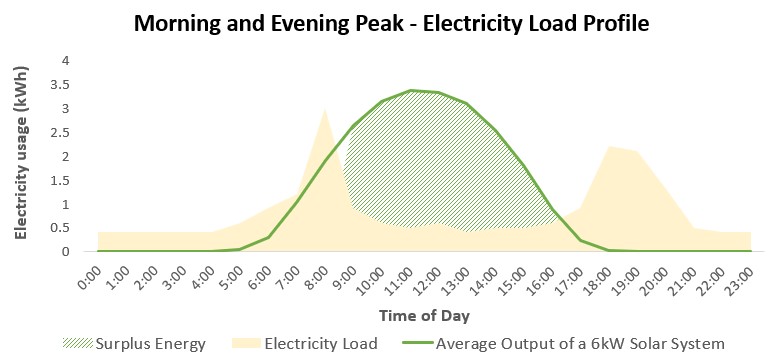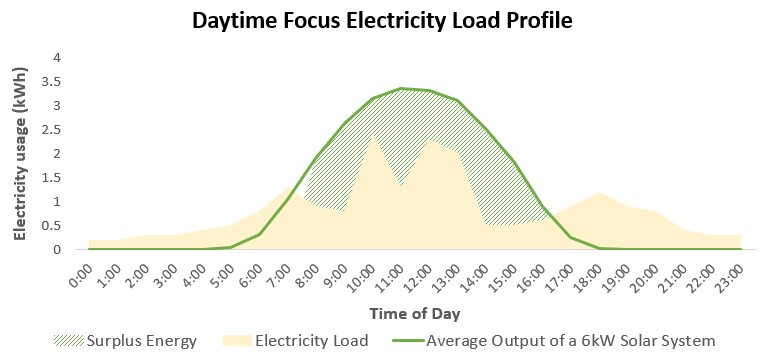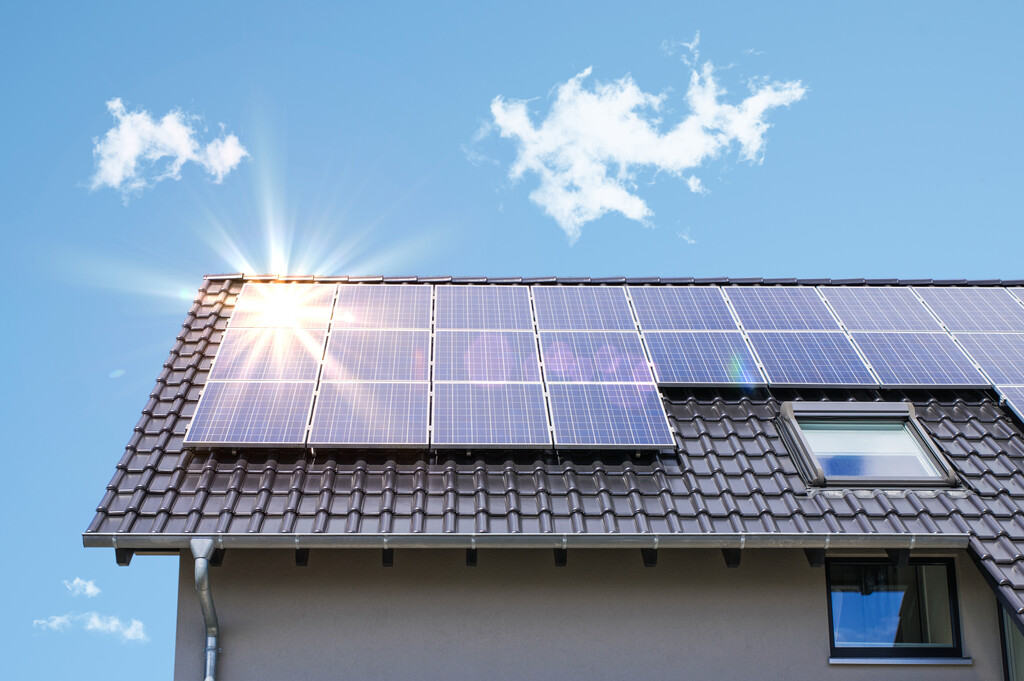It can be difficult to know what the best size solar system for you is.
Solar salesmen frequently receive incentives to encourage customers to purchase the largest possible system. Usually, it won’t deliver the best return on investment.
This article looks at how to calculate the best size solar system for your needs.
How to calculate what size solar system you need
The rates you will be paid by the electricity retailers for solar power sold back into the grid (Feed in tariff) have decreased considerably over the last decade. This has led to a key design principle that should be considered:
Solar systems with the best return on investment match the solar output to the daytime energy requirements of the home.
By matching the solar power generation to the energy requirements of the home you are minimising the amount of surplus energy to be sold to the grid. With the low feed in tariffs selling power back to the grid is no longer financially attractive.
Compare solar quotes online now.
Your electricity load profile is important:
Your electricity load profile considers how you use electricity through-out the day.
A typical home uses most energy in the mornings and evenings as people are often at work or school during the daytime. See below example.

Key assumptions:
- Energy usage is 20kWh per day
- Solar system is installed in Sydney with panels facing north at 15 degrees
- Average output – actual solar generation is higher in summer and lower in winter
Generating solar power while having limited electricity usage is not the most ideal scenario. In this example, the home is using 20kWh of energy per day and the 6kW system would offset 40% of the homeowner’s electrical usage.
With an electricity tariff of 30c per kWh and feed in tariff of 7c per kWh this customer would save $3.56 per day and $1,300 per year.
Solar systems have higher returns on investment with daytime power usage or shiftable loads during the day. Consider using timers for major energy loads like hot water systems, pool pumps, dishwashers, and washing machines to run in the daytime.
The below example has more of the energy shifted into the daytime.

This customer has been able to offset 64% of their energy usage with the same size solar system.
With the same assumption on electricity rates, this would improve the savings to $4.67 per day or $1,703 per year.
Which size solar system is best?
Using our solar system payback calculator, we have identified the optimal solar system for these two electricity usage scenarios.
We can see that for 20kWh electricity usage under a morning and evening peak profile, the best solar system size is 6kW for return on investment. For the daytime focus electricity load profile, the best size is 6kW.
Best solar system size for Morning and Evening Peak
| System Size | Install Cost | Annual Savings | Payback Period |
| 3kW | $3,650 | $821 | 5.1 Years |
| 4kW | $4,080 | $985 | 4.8 Years |
| 5kW | $4,600 | $1,130 | 4.7 Years |
| 6kW Optimal | $4,910 | $1,266 | 4.6 Years |
| 7kW | $5,930 | $1,394 | 4.9 Years |
| 10kW | $8,190 | $1,757 | 5.3 Years |
Best solar system size for Morning and Evening Peak
| System Size | Install Cost | Annual Savings | Payback Period |
| 3kW | $3,650 | $890 | 4.3 Years |
| 4kW | $4,080 | $1,165 | 4.2 Years |
| 5kW | $4,600 | $1,305 | 4.3 Years |
| 6kW Optimal | $4,910 | $1,437 | 4.2 Years |
| 7kW | $5,930 | $1,563 | 4.5 Years |
| 10kW | $8,190 | $1,922 | 4.9 Years |
- Electricity rate of 30c per kWh and feed in tariff of 7c per kWh
- Solar system prices are based on Sydney prices in Solar Choice Price Index
- System generation based on Sydney install with panels facing north at 30 degrees
Smaller system sizes drop off in ROI as the price per kW installed is more expensive. Unless there is limited roof space, it is rare to see systems installed that are smaller than 6kW.
You can input your own electricity rates into our simple payback calculator to work out the best solar system size in your circumstances.
Compare solar quotes online now.
Oversizing your system for future needs
Expanding the size of your solar system later down the track is possible but will incur more costs than installing a larger system at the outset.
Often homeowners will select a slightly larger system size to account for future growth in energy usage.
The following things are likely to significantly increase electricity usage in your home:
- Installation of Air Conditioning unit
- Adding a granny flat or second dwelling
- Putting in a swimming pool
- Converting gas to electric (stove, hot water, heating)
- Working from home
- Buying an electric vehicle
- Installing a solar battery
If some of these listed plans are likely for you, you may wish to consider adding some more capacity to your system upfront to avoid a more costly process to expand the system down the track.
Reasons you may not end up buying the best size solar system
In some cases, it may not be possible to get the best size solar system for optimal return on investment.
The network may impose restrictions on customers regarding the size of the system they can install. The available roof space that is free of shading also plays a role in determining the number of solar panels you can get on the roof.
Some customers may also be limited by their budget.
What size solar battery do I need?
The investment cost of batteries in many cases makes them economically unviable if you are simply looking to save money. We’ve look in depth at the return on investment in our article – are solar batteries worth it?
Many customers are still installing batteries with some of the below goals in mind:
- 100% energy independence (literally ‘off-grid’): Some customers are looking to be completely self-reliant and install enough solar and battery capacity to eliminate the need for grid power. Usually this means installing enough battery capacity to cover 2-3 days of energy usage and having a back-up generator. Check out a ‘reality check’ list of things to consider before going off-grid here.
- 70-80% energy independence – Targeting 70-80% of your power usage with solar and batteries can reduce the upfront costs significantly. This means you don’t have to oversize your system to cover the occasional multi-day bad weather system. You can seamlessly draw power from grid where needed whilst all but eliminating your power bills.
- Peak time independence: Many customers across Australia are on time-of-use rates meaning they get charged much higher rates during peak periods. Designing a battery to cover peak periods (only) will improve the return on investment. Most battery solutions can also be programmed to only discharge at certain times of day to ensure you are maximising your ROI.
- Battery storage as emergency backup: Often only a small battery is required to cover an ‘emergency circuit’ which covers essential loads like fridges, lighting and security systems.
Since 2008 our knowledge and sophisticated software has allowed over 300,000 Australian households and businesses to make a well-informed choice on their solar & battery installer.
Frequently Asked Questions (FAQs) About Solar System Sizing
How do I calculate what size solar system I need?
To calculate the right solar system size, start by analyzing your electricity consumption, particularly during daylight hours. Review your electricity bills to determine your average daily kWh usage. Consider your energy load profile—how much power you use at different times of the day—and match your solar output to your daytime usage. Using an online solar payback calculator can also help you estimate the ideal system size based on your location, energy rates, and consumption patterns.
Is a 10kW solar system too big?
Whether a 10kW solar system is too big depends on your household’s energy consumption and future energy needs. For a typical home, a 10kW system might be more than necessary if your daily usage is low, leading to excess energy being sold back to the grid at lower feed-in tariffs. However, if you have high energy consumption, plan to add electric vehicles, or anticipate future energy-intensive upgrades, a 10kW system could be appropriate.
Is a 6.6kW solar system big enough?
A 6.6kW solar system is a popular choice for many households as it generally provides a good balance between cost and energy production. It is often sufficient for average-sized homes with moderate energy consumption. However, its adequacy depends on your specific energy usage patterns, the efficiency of the system, and your location. If you use most of your electricity during the day, a 6.6kW system can typically cover a significant portion of your energy needs.
How big of a solar system do I need for my home?
The size of the solar system you need depends on several factors, including your average daily energy consumption, roof space, budget, and whether you plan to add more energy-intensive devices or appliances in the future. On average, most homes require a system between 5kW and 7kW, but this can vary widely. It’s advisable to consult with a solar expert who can assess your specific needs and recommend the best system size for your home.
- Why a big battery could be cheaper than a small battery with the federal rebate? - 19 June, 2025
- Heat Pump Costs – Solar Choice Price Index - 1 June, 2025
- Solar Panel Costs: Solar Choice Price Index | July 2025 - 1 June, 2025
Related Posts
- 65kW solar installation for Coastal Cold Storage (brokered by Solar Choice) (31 Jul, 2018)
- Commercial Solar PV Price Index for January 2018 (31 Jan, 2018)
- Commercial Solar PV Price Index for July 2017 (31 Jul, 2017)
